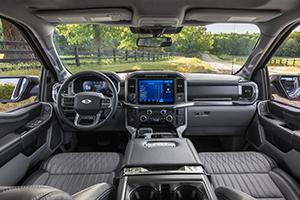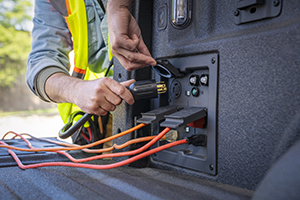2021 Ford F-150
As you can imagine, as the best selling vehicle in America year after year, we’ve tested an awful lot of Ford F-150 pickups over four-decades of MotorWeek. And if there’s a common thread, it’s innovation. Now, if like us, you’re wondering, “What will they think of next?” Well, let’s find out, with a test of the new 14th generation Ford F-150.
American’s sure love their pickup trucks. And for going on 44 years now, the Ford F-150 is the one they’ve loved the most. That’s quite a run; and based on our experience with this 2021 Ford F-150, things are not about to change any time soon.
 Full-size pickup trucks are still one segment that gives you a lot of options for power; Ford, even more than most, currently with 6-engines choices. Base, is a 290-horsepower 3.3-liter V6; also available are a 325-horsepower 2.7-liter EcoBoost V6 turbo, a 400-horsepower 3.5-liter EcoBoost V6 turbo, a 250-horsepower 3.0-liter V6 turbo-diesel, plus Ford has a new gas-electric in the mix with a 3.5-liter V6-based full hybrid outputting 430-horsepower. Oh, and there’s even a pure EV F-150 on the way too!
Full-size pickup trucks are still one segment that gives you a lot of options for power; Ford, even more than most, currently with 6-engines choices. Base, is a 290-horsepower 3.3-liter V6; also available are a 325-horsepower 2.7-liter EcoBoost V6 turbo, a 400-horsepower 3.5-liter EcoBoost V6 turbo, a 250-horsepower 3.0-liter V6 turbo-diesel, plus Ford has a new gas-electric in the mix with a 3.5-liter V6-based full hybrid outputting 430-horsepower. Oh, and there’s even a pure EV F-150 on the way too!
Now, our XLT tester stuck with the tried and true naturally-aspirated 5.0-liter V8 with 400-horsepower and 410 lb-ft. of torque. Adding the Max Trailer Tow Package, with trailer brake controller, and a 3.73 rear, sets this 4X4 up to pull 12,900-lbs.; Heavy Duty territory not that long ago.
New this year, a 10-speed automatic transmission now comes with all engines.
Even better power-related news is Ford’s new and innovative Pro Power Onboard generators. There are 3 different sizes depending on engine; ranging from 2 to 7.2-kW with the hybrid. The smallest 2-kw version here can power a saw while still charging cordless tool batteries at the jobsite. Just think how Pro Power can come in handy during emergencies.
While the frame is largely the same, wheelbases have been stretched a little, ranging from 122.8 to 164.1 inches. Same choices of Regular, extended SuperCab, and full 4-door SuperCrew cabs; with 3 bed lengths of 5½, 6½, and 8-feet.
Body panels remain aluminum, track width has been widened slightly, and it sits a little taller. With ever more exterior choices including 13 different wheels options, from 17 to 22-inches; as well as 11 different grille designs.
 As beds get taller and taller, they’re also getting harder and harder to access; Ford helps with optional running boards that extend to the bed for stepping up to reach in from the side, and incorporating a step into the tailgate for actually climbing in.
As beds get taller and taller, they’re also getting harder and harder to access; Ford helps with optional running boards that extend to the bed for stepping up to reach in from the side, and incorporating a step into the tailgate for actually climbing in.
There are plenty of things inside to make your truck-life easier as well; including a fold-down work surface in the console for a laptop.
And of course connectivity is an increasingly important part of all vehicles, whether for work or play. So, most F-150s will get a 12-inch center touchscreen with SYNC 4; an 8-inch screen is standard on XL and XLT with most of the same functions.
Plenty of room in all seating positions, including rear seat center, making 3-across with your workmates less awkward than ever.
Overall, the interior is quite pleasant and a small step up for F-150s; but it is one area that it perhaps falls behind the competition. It certainly doesn’t have the luxury-car feel of the Ram.
Nor does it have the Ram’s daily driver comfort; still feeling more workman-like, which we acknowledge also has its appeal to many who still want to feel like they’re driving a truck.
No worries about this truck making it to the jobsite on time. Our XLT’s 5.0-liter showed its Mustang roots with a sprint to 60 of just 5.9-seconds. Power comes on hard, and with an empty bed, the rears definitely struggle for grip; but of course we wouldn’t have it any other way.
 Shifts from the 10-speed auto are very smooth and relatively quick, with little to no power drop-off between them. Obviously not the most aero of vehicles, you expect to run out of steam going down the track, but when we finished the ¼-mile in 15.2-seconds at 98 miles-per-hour, this truck felt like it was just getting started.
Shifts from the 10-speed auto are very smooth and relatively quick, with little to no power drop-off between them. Obviously not the most aero of vehicles, you expect to run out of steam going down the track, but when we finished the ¼-mile in 15.2-seconds at 98 miles-per-hour, this truck felt like it was just getting started.
Government Fuel Economy Ratings for our 5.0-liter 4X4 are 16-City, 22-Highway, and 19-Combined. Our winter test loop was on the low end at 16.3 miles-per-gallon of Regular.
Those ratings mean a below average Energy Impact Score; 17.3-barrels of yearly oil consumption, with 7.9-tons of CO2 emissions.
Depending on your priorities, you can spend a lot or a little on a new F-150. Pricing starts at just $31,295 for a 2-wheel-drive 6-cylinder Regular Cab short bed, and goes all the way to $73,115 for a Limited. You don’t need to spend that much though; our well-equipped XLT SuperCrew came in under $57,000. The cost of 4-wheel-drive varies with configuration. And, King Ranch, Platinum, and Limited trims are only available as SuperCrews.
Times change, fads come and go, and new technologies are constantly arriving. Yet, through it all, the F-150 continues to be the most sought-after vehicle in America. So, for Ford, it’s business as usual; and for everyone else in the segment, it’s back to work to see what they can do to top the 2021 Ford F-150.
Specifications
- Engine: 5.0L V8
- Horsepower: 400
- Torque: 410 lb-ft
- 0-60 mph: 5.9 seconds
- 1/4 Mile: 15.2 seconds @ 98 mph
- EPA: 16 City / 22 Highway / 19 Combined





